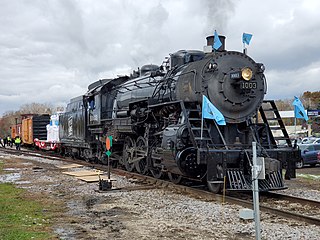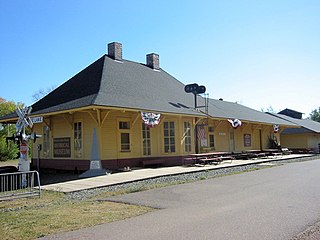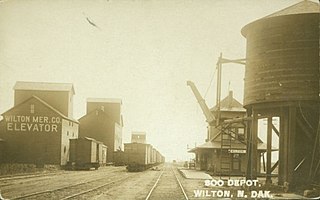
The Soo Line Railroad is one of the primary United States railroad subsidiaries for the CPKC Railway, one of six U.S. Class I railroads, controlled through the Soo Line Corporation. Although it is named for the Minneapolis, St. Paul and Sault Ste. Marie Railroad (MStP&SSM), which was commonly known as the Soo Line after the phonetic spelling of Sault, it was formed in 1961 by the consolidation of that company with two other CPKC subsidiaries: The Duluth, South Shore and Atlantic Railway, and the Wisconsin Central Railway. It is also the successor to other Class I railroads, including the Minneapolis, Northfield and Southern Railway and the Chicago, Milwaukee, St. Paul and Pacific Railroad. On the other hand, a large amount of mileage was spun off in 1987 to Wisconsin Central Ltd., now part of the Canadian National Railway. The Soo Line Railroad and the Delaware and Hudson Railway, CPKC's other major subsidiary, presently do business as the Canadian Pacific Railway (CP). Most equipment has been repainted into the CP scheme, but the U.S. Surface Transportation Board groups all of the company's U.S. subsidiaries under the Soo Line name for reporting purposes. The Minneapolis headquarters are in the Canadian Pacific Plaza building, having moved from the nearby Soo Line Building.

The Minneapolis, Northfield and Southern Railway was an 87-mile (140 km) long American shortline railroad connecting Minneapolis and Northfield, Minnesota. It was incorporated in 1918 to take over the trackage of the former Minneapolis, St. Paul, Rochester and Dubuque Electric Traction Company, also known as the Dan Patch Lines. On June 2, 1982, it was acquired by the Soo Line Railroad, which operated it as a separate railroad until merging it on January 1, 1986, along with the Chicago, Milwaukee, St. Paul and Pacific Railroad.

The Osceola and St. Croix Valley Railway is a heritage railroad in Osceola, Wisconsin owned and operated by the Minnesota Transportation Museum. It operates on former Minneapolis, St. Paul and Sault Ste. Marie Railroad trackage now owned by the Canadian National Railway.

The Huron Central Railway is a railway operating in northern Ontario, Canada. It is operated by Genesee & Wyoming Canada, the Canadian subsidiary of Genesee & Wyoming.

The Minnesota Northwestern Electric Railway was an interurban gasoline-electric railway which operated passenger and freight service between Thief River Falls, Minnesota and Goodridge, Minnesota, operating from 1914 to 1940. The railway also served Silverton Township and Mavie. There were several other stops along the way. The original plan was to extend the line all the way to International Falls, Minnesota, however due to poor finances, the line never extended beyond Goodridge.

The Soo Line High Bridge, also known as the Arcola High Bridge, is a steel deck arch bridge over the St. Croix River between Stillwater, Minnesota and Somerset, Wisconsin, United States. It was designed by structural engineer C.A.P. Turner and built by the American Bridge Company from 1910 to 1911. The bridge was listed on the National Register of Historic Places in 1977 for its national significance in the themes of engineering and transportation. It was nominated for its exceptional dimensions, beauty, innovative engineering techniques, and importance to transportation between Minnesota and Wisconsin.

Crosby station is a historic former train station in Crosby, Minnesota, United States. It was established in 1910. It was listed on the National Register of Historic Places in 1980 as the Crosby Railroad Depot for having local significance in the themes of commerce, industry, and transportation. The depot was nominated for being an essential conduit for the arrival of goods and people and the export of iron ore during central Crow Wing County's economic boom years.
In October 1904 the Minneapolis, St. Paul and Sault Ste. Marie Railway and Canadian Pacific Railway began overnight passenger service between the Twin Cities and Winnipeg, Manitoba. The train consisted of a mail and baggage cars, two coaches, a sleeper and dining car. The train went by several names over its 62 years: Manitoba Express (1904–1909), Winnipeg Express (1919–1928) and the Winnipeger (1928–1967). It commonly was called the Winnipeg Flyer.

The Soo Line L-1 class was a class of ten 2-8-2 (Mikado) steam locomotives built by the American Locomotive Company in 1913 for the Minneapolis, St. Paul and Sault Ste. Marie Railway.
Soo Line Depot may refer to the following train stations used by the Soo Line Railroad:

The Minneapolis, St. Paul and Sault Ste. Marie Railroad (MStP&SSM) was a Class I railroad subsidiary of the Canadian Pacific Railway in the Midwestern United States. Commonly known since its opening in 1884 as the Soo Line after the phonetic spelling of Sault, it was merged with several other major CP subsidiaries on January 1, 1961, to form the Soo Line Railroad.
Radium is an unincorporated community in section 19 of Comstock Township, Marshall County, Minnesota, United States. It was built alongside the Minneapolis, St. Paul and Sault Ste. Marie Railroad branch line built in 1905 from Thief River Falls, Minnesota, to Kenmare, North Dakota. The place was named for the element radium. Radium had its own post office from 1905 to 1984. Since 1984, Radium has been served by the post office in Warren. It is also on the Warren telephone exchange and part of the Warren-Alvarado-Oslo school district. The townsite is being slowly reclaimed for use as farmland. There is still a large grain elevator on the railroad line south of the townsite. A small Lutheran church 1+1⁄2 miles (2.4 km) south of the town antedates the coming of the railroad; Immanuel Lutheran Church (LCMS) was organized in 1897.

Moose Lake station in Moose Lake, Minnesota, United States, is a depot built in 1907 by the Soo Line Railroad. The building was one of the few buildings that survived the 1918 Cloquet Fire, and it was used to provide shelter for those left homeless in the fires. It was listed on the National Register of Historic Places in 1994 as the Minneapolis, St. Paul, and Sault Ste. Marie Depot.
Two former railroad stations are listed on the National Register of Historic Places as Minneapolis, St. Paul and Sault Ste. Marie Depot:

Wilton station in Wilton, North Dakota, USA, was built in 1900 by the Minneapolis, St. Paul and Sault Ste. Marie Railroad. Designed by William J. Keith, it was listed on the National Register of Historic Places in 1978 as the Minneapolis, St. Paul and Sault Sainte Marie Railroad Company Depot. It is also known as Soo Line Depot.

Outlook station is a railway depot in Outlook in Sheridan County, Montana which was listed on the National Register of Historic Places in 1993 as the Outlook Depot. It has also been known as Soo Line Depot. The listing included two contributing buildings.

The Midland Continental Railroad is a defunct shortline railroad which operated in the U.S. state of North Dakota between 1906 and 1966. The railroad was envisioned as a trunk line running from Winnipeg, Manitoba, Canada to Galveston, Texas. Financing problems led to the completion of only two segments totalling 77 miles (124 km).

The Osceola Depot is a historic railroad station located at 114 Depot Rd. in Osceola, Wisconsin. The station was built in 1916 for the Minneapolis, St. Paul and Sault Ste. Marie Railroad. Later, the line would become a part of the Soo Line Railroad and eventually Canadian National. Today, the depot serves as a part of the Minnesota Transportation Museum as the starting point for a heritage railway.

Remer station in Remer, Minnesota, United States, is a depot built around 1910 by the Soo Line Railroad. It was listed on the National Register of Historic Places in 1980 as the Soo Line Depot.


















